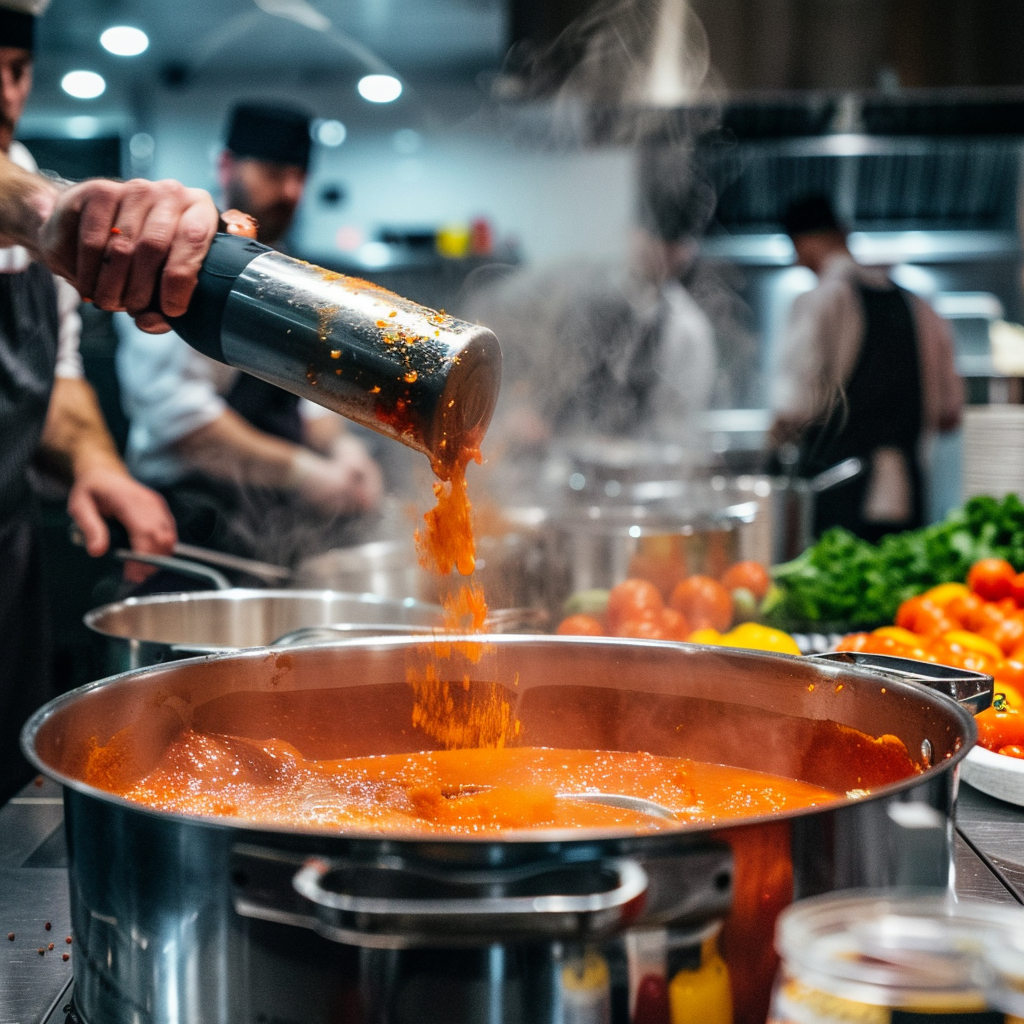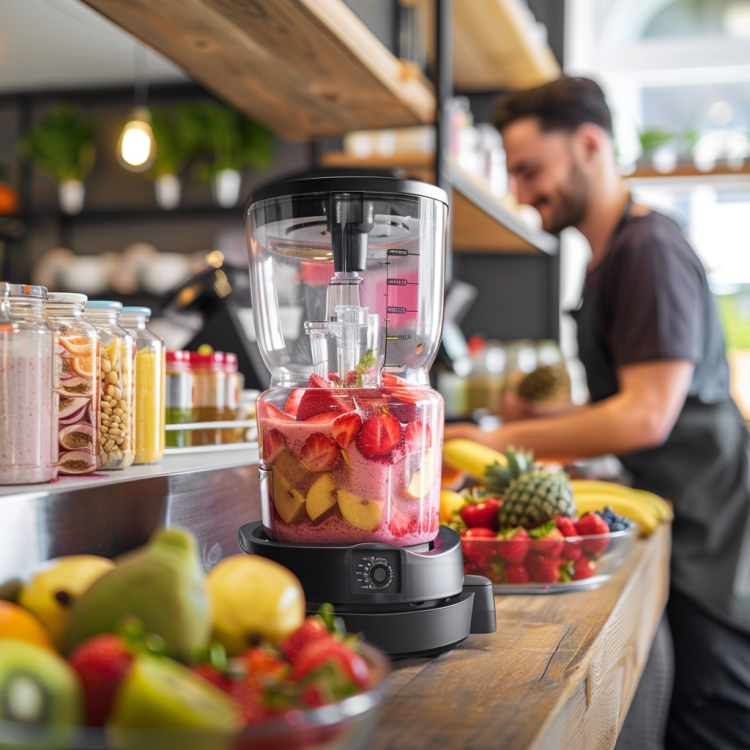
A commercial immersion blender, also known as a stick blender or hand blender, is a versatile and powerful tool used in professional kitchens for a wide variety of tasks. Unlike household models, commercial immersion blenders are designed to handle heavy-duty tasks and larger quantities of food, making them essential for restaurants, catering businesses, and other food service operations.
One of the primary uses of a commercial immersion blender is to blend large quantities of soups and sauces directly in the cooking pot. This eliminates the need to transfer hot liquids to a countertop blender, which can be cumbersome and risky. The powerful motor of a commercial immersion blender can quickly puree even large batches of ingredients into a smooth consistency, saving time and effort. This is particularly useful for preparing velvety soups like bisques or creamy sauces that require a perfectly smooth texture.
In addition to soups and sauces, commercial immersion blenders are commonly used to emulsify dressings and sauces. The blender’s ability to mix oil and water-based ingredients together smoothly makes it ideal for creating mayonnaise, vinaigrettes, and hollandaise sauce. The control over speed and consistency allows chefs to achieve the exact texture they need for each dish, whether it’s a light, airy foam or a thick, rich emulsion.
Commercial immersion blenders are also effective for whipping and aerating ingredients. For example, they can be used to whip cream, create foams, or beat eggs, providing a quick and efficient way to prepare these ingredients in large quantities. The blender’s power and versatility make it possible to achieve consistent results every time, which is critical in a professional kitchen environment.
Furthermore, commercial immersion blenders are used to blend and mix ingredients for batters and doughs. Their robust design allows them to handle thicker mixtures, such as pancake or waffle batter, without overworking the motor. This makes them particularly useful in bakeries or any establishment that needs to prepare large batches of batter quickly and efficiently.
Another significant use of a commercial immersion blender is in making purees and baby food. The powerful motor and sharp blades can quickly puree fruits, vegetables, and other ingredients to the desired consistency, making it an excellent tool for preparing smooth purees or chunky mixtures depending on the need. This application is especially valuable in commercial kitchens that cater to specific dietary needs or in establishments that prepare baby food in-house.
Why Would You Use an Immersion Blender?
An immersion blender is used for its convenience, versatility, and efficiency in handling a variety of kitchen tasks. One of the primary reasons to use an immersion blender is its ability to blend, puree, and emulsify directly in the container where the food is being prepared. This feature makes it an invaluable tool for creating soups, sauces, and dressings without the need to transfer the contents to another appliance, which not only saves time but also reduces the risk of spills and additional cleanup.
Another reason to use an immersion blender is its compact and portable design. Unlike traditional blenders, which require counter space and can be bulky to handle, an immersion blender is lightweight and easy to maneuver. This portability allows it to be used in different pots, pans, or bowls, making it extremely versatile in the kitchen. For instance, you can easily switch from blending soup in a stockpot to whipping cream in a mixing bowl with minimal effort.
The immersion blender’s ability to control the consistency of food is another key advantage. By adjusting the speed and blending time, you can achieve different textures, from smooth purees to chunky mixtures. This makes it ideal for preparing a wide range of dishes, from creamy soups to salsas and pestos. The control over texture is especially important in professional kitchens where consistency and quality are crucial.
Additionally, immersion blenders are often used for tasks that require emulsifying or whipping. For example, when making mayonnaise or salad dressings, an immersion blender can quickly and efficiently combine oil and other liquids into a smooth, stable emulsion. Similarly, it can be used to whip cream or froth milk for desserts and beverages, providing a quick and effective way to add a finishing touch to a dish.
Immersion blenders are also favored for their ease of cleaning. Since they typically consist of a detachable blending arm and motor unit, they are much easier to clean than traditional blenders with multiple parts. This makes them particularly appealing in busy kitchens where time is of the essence. Simply detach the blending arm, rinse or wash it, and it’s ready for the next task.

What is the Purpose of a Commercial Blender?
The purpose of a commercial blender, including both immersion and countertop models, is to efficiently process large volumes of food in a professional kitchen setting. These blenders are designed to handle heavy-duty tasks that go beyond the capabilities of standard household blenders. Their primary function is to blend, puree, emulsify, and sometimes chop or grind ingredients quickly and consistently.
One of the main purposes of a commercial blender is to prepare large quantities of food in a short amount of time. Whether it’s blending soup for dozens of servings, pureeing large batches of vegetables, or making gallons of smoothies, a commercial blender is built to handle these tasks with ease. The powerful motors in these blenders ensure that they can process tough ingredients like ice, nuts, or fibrous vegetables without slowing down or overheating.
Commercial blenders are also used to achieve a high level of consistency in food preparation. In a professional kitchen, the texture and quality of dishes must be consistent for every serving. A commercial blender ensures that soups are uniformly smooth, sauces are perfectly emulsified, and batters are evenly mixed, regardless of the quantity being prepared. This consistency is crucial in maintaining the quality of dishes in restaurants, hotels, and catering businesses.
Another important purpose of commercial blenders is to support the preparation of specialized or high-volume foods. For example, in a smoothie bar or juice shop, a commercial blender might be used all day long to blend fruits, vegetables, and ice into smooth, consistent beverages. The durability and power of a commercial blender make it possible to handle this high demand without compromising on the quality of the product.
Commercial blenders also play a vital role in food safety and sanitation in professional kitchens. They are often designed with features that make them easy to clean and sanitize, which is essential in preventing cross-contamination and ensuring food safety. The ease of disassembly and cleaning means that commercial kitchens can maintain high standards of hygiene while efficiently preparing food.
What All Can an Immersion Blender Be Used For?
An immersion blender is an incredibly versatile kitchen tool that can be used for a wide range of culinary tasks. Its primary function is to blend ingredients directly in the container where they are being prepared, but its uses extend far beyond simple blending.
One of the most common uses for an immersion blender is making soups and sauces. Whether you’re preparing a creamy tomato soup, a velvety bisque, or a rich gravy, an immersion blender allows you to puree the ingredients directly in the pot without transferring them to a traditional blender. This not only saves time but also reduces the risk of spills and burns, especially when working with hot liquids.
Immersion blenders are also ideal for making smooth purees and baby food. The powerful blades can quickly turn cooked fruits, vegetables, and meats into a fine puree, making it easy to prepare nutritious meals for babies or those with specific dietary needs. The ability to blend directly in the cooking container ensures that the food retains its flavor and nutritional value.
In addition to soups and purees, an immersion blender can be used to create emulsions such as mayonnaise, hollandaise sauce, or salad dressings. The blender’s ability to mix oil and water-based ingredients smoothly ensures a stable emulsion, which is essential for the texture and taste of these dishes. The precise control over the blending process also allows you to achieve the exact consistency required.
Another popular use for an immersion blender is whipping and aerating ingredients. For example, you can use it to whip cream, beat egg whites, or froth milk for lattes and cappuccinos. The immersion blender’s design allows it to incorporate air into the ingredients quickly, creating light and fluffy textures that are perfect for desserts and beverages.
Baking enthusiasts will also find an immersion blender useful for preparing batters and doughs. It can be used to mix pancake or waffle batter, blend cake mix, or even knead dough for bread. The powerful motor can handle thicker mixtures, ensuring that ingredients are evenly incorporated without overworking the batter or dough.
Finally, immersion blenders are excellent for preparing salsas, pestos, and dips. By pulsing the blender, you can achieve a chunky texture that is perfect for these types of dishes. The convenience of blending directly in a bowl or container makes it easy to adjust the consistency and flavor as you go, giving you complete control over the final product.

In conclusion, a commercial immersion blender is a versatile and essential tool in any professional kitchen, capable of handling a wide range of tasks from blending soups and sauces to whipping cream and mixing doughs. Its ability to process large quantities of food quickly and consistently makes it invaluable for chefs and food service professionals alike.



